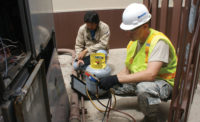DOLLARS AND CENTS
Last year, Emerson Climate Technologies began surveying contractors and distributors in an effort to gauge their R-22 phaseout preparedness. In May of 2007, the manufacturer’s 2010 Refrigerant Transition Survey found that although everyone seemed to know about the impending change, 40 percent of those surveyed determined that they would wait until the 2010 deadline before converting their sales to R-410A equipment. In the November release, however, the numbers shifted somewhat and the urgency to meet the 2010 deadline ramped up as customers began demanding R-410A equipment.According to Emerson’s research, 15 percent of those surveyed - up from 10 percent in May - reported that more than 40 percent of their customers are requesting R-410A equipment.

In fact, Emerson reported that two-thirds of those surveyed said they cite both environmental concerns and long-term costs when explaining the benefits of R-410A equipment to their customers.
According to respondents, “maintenance expenses” and “being better for the environment” are the two most popular R-410A selling points. Other selling points include efficiency, new technology arguments, a better and longer warranty, improved comfort level, and longer life and greater reliability. Nine percent said they did not promote or sell R-410A and 24 percent of the respondents said their customers don’t ask for R-410A. As awareness increases, however, this number decreases, as evidenced in the 3 percent drop from the May 2007 report.

R-410A RECOMMENDED
Selling R-410A requires some new tactics, and when more than one-third of the industry (39 percent) is still intending to wait until 2010 to convert the majority of their sales to R-410A equipment, Emerson questioned respondents as to why they recommend R-22 over R-410A.“The predominant answers were retrofit concerns and short-term economics,” said the manufacturer. “They pointed to the fact that R-22 has a lower price to their customers for outdoor and indoor equipment.”
According to Emerson, however, “the cost picture changes when discussing refrigerants themselves.” The survey shows that contractors and distributors are reporting a steady and dramatic price increase, ranging from 20 to 100 percent, in the past few years.
“With contractors and distributors already reporting significant price increases for replacement R-22 refrigerant, the industry must focus on the realities of long-term cost and availability of replacement parts and refrigerant, and thus the importance of making the switch to HFCs like R-410A as quickly as possible,” said Scott Barbour, president, Emerson Climate Technologies Air Conditioning Division.
Cost isn’t the only concern that contractors and distributors are facing. The surveyed respondents also reported being extremely concerned with retrofits, future availability of R-22, full model line availability of R-410A commercial and residential equipment, equipment failures due to improper installation, increased repair of R-22 versus replacement with R-410A, changes in refrigerant characteristics, and inadequate training or skills. In spite of these and other concerns, the survey reported that 64 percent of the respondents are currently training their staff to service and install R-410A equipment.
“We are glad to see that more HVAC professionals are beginning to transition their business toward R-410A-bearing equipment in advance of 2010,” said Barbour. “This latest survey tells us that the industry is accelerating the transition, but we need to continue increasing the forward momentum to ensure we are all prepared to provide the best, most responsible options for our customers.”
For more information, visit www.emersonclimate.com/refrigerant/ac.
Publication date:05/12/2008





